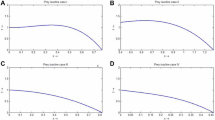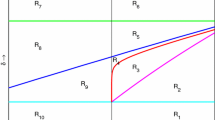Abstract
Provision of additional food supplements for the purpose of biological conservation has been widely researched both theoretically and experimentally. The study of these biosystems is usually done using predator–prey models. In this paper, we consider an additional food provided predator–prey system in the presence of the inhibitory effect of the prey. This model is analyzed in the control parameter space using the control parameters, quality and quantity of additional food. The findings suggest that with appropriate choice of additional food to predators, the biosystem can be controlled and steered to a desirable state. It is also possible to eliminate either of the interacting species. The vital role of the quality and quantity of the additional food in the system dynamics cautions the eco manager on the choice of the additional food for realizing the goal in the biological conservation programme.







Similar content being viewed by others
References
Birkhoff G, Rota GC (1989) Ordinary differential equations. John Wiley & Sons, Hoboken
Butler GJ et al (1986) Uniformly persistent systems. Proc Am Math Soc 96:425–429
Cesari L (1983) Optimization—theory and applications: problems with ordinary differential equations, applications of mathematics series, vol 17. Springer, New York
Collings JB (1997) The effects of the functional response on the bifurcation behavior of a mite predator prey interaction model. J Math Biol 36:149–168
David S (1995) Hik: does risk of predation influence population dynamics? Evidence from the cyclic decline of Snowshoe Hares. Wildl Res 22:115–129
Elkinton Joseph S et al (2004) Effects of alternative prey on predation by small mammals on gypsy moth pupae. Popul Ecol 46:171–178
Freedman HI, Wolkowicz GSK (1986) Predator–prey systems with group defence: the paradox of enrichment revisited. Bull Math Biol 48:493–508
Glaser O (1983) Wintergattermanagement: Fallstudien in obsersteirischen rotwildgattern. Diploma Thesis. Agricultural University of Vienna
Harmon JP (2003) Indirect interactions among a generalist predator and its multiple foods, Ph.D Thesis. University of Minnesota, St. Paul, MN
Holt RD (1984) Spatial heterogeneity, indirect interactions, and the coexistence of prey species. Am Nat 124:377–406
Huang JC, Xiao DM (2004) Analysis of bifurcations and stability in a predator–prey system with holling type-IV functional response. Acta Math Appl Sin Engl Ser 20:167–178
Huang J et al (2014) Bifurcations in a predator–prey system of Leslie type with generalized Holling type III functional response. J Differ Eq 257:1721–1752
Kar TK (2012) Bapan Ghosh: sustainability and optimal control of an exploited prey predator system through provision of alternative food to predator. BioSystems 109:220–232
Kot M (2001) Elements of mathematical ecology. Cambridge University Press, Cambridge
Kozak HM et al (1994) Supplemental winter feeding. Rangelands 16:153–156
Kozak JM et al (1995) Winter feeding, lactation and calf growth in farmed wapiti. Rangelands 17:116–120
Liberzon D (2012) Calculus of variations and optimal control theory: a concise introduction. Princeton University Press, Princeton
Putman RP, Staines BW (2004) Supplementary winter feeding of wild red deer Cervus elaphus in Europe and North America: justifications, feeding practice and effectiveness. Mamm Rev 34:285–306
Redpath SM et al (2001) Does supplementary feeding reduce predation of red grouse by hen harriers? J Appl Ecol 38:1157–1168
Sahoo B, Poria S (2014) Effects of supplying alternative food in a predator–prey model with harvesting. Appl Math Comput 234:150–166
Sahoo B, Poria S (2015) Effects of additional food in a delayed predator–prey model. Math Biosci 261:62–73
Srinivasu PDN et al (2007) Biological control through provision of additional food to predators: a theoretical study. Theor Popul Biol 72:111–120
Srinivasu PDN, Vamsi DKK, Aditya I (2018) Biological conservation of living systems by providing additional food supplements in the presence of inhibitory effect: a theoretical study using predator–prey models. Differ Eq Dyn Syst 26:213–246
Zhu H et al (2002) Bifurcation analysis of a predator–prey system with nonmonotonic function response. SIAM J Appl Math 63:636–682
Acknowledgements
The authors dedicate this paper to the founder chancellor of Sri Sathya Sai Institute of Higher Learning, Bhagawan Sri Sathya Sai Baba. The corresponding author also dedicates this paper to his loving elder brother D. A. C. Prakash who still lives in his heart. The second author acknowledges the partial financial support from SAI-DAMCS fund of SSSIHL for this work.
Author information
Authors and Affiliations
Corresponding author
Additional information
Publisher's Note
Springer Nature remains neutral with regard to jurisdictional claims in published maps and institutional affiliations.
Rights and permissions
About this article
Cite this article
Vamsi, D.K.K., Kanumoori, D.S.S.M. & Chhetri, B. Additional Food Supplements as a Tool for Biological Conservation of Biosystems in the Presence of Inhibitory Effect of the Prey. Acta Biotheor 68, 321–355 (2020). https://doi.org/10.1007/s10441-019-09371-x
Received:
Accepted:
Published:
Issue Date:
DOI: https://doi.org/10.1007/s10441-019-09371-x




